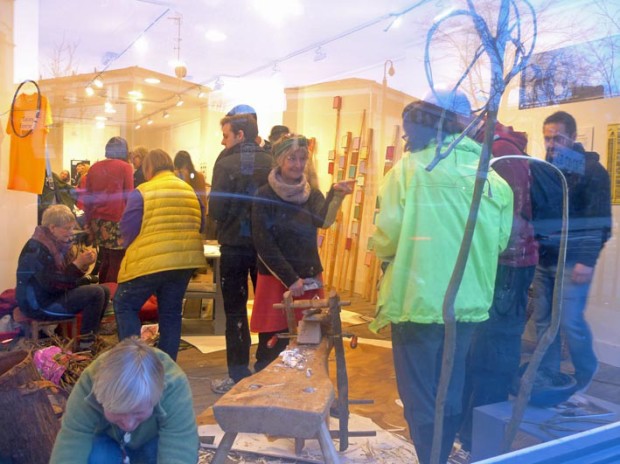You have no items in your cart. Want to get some nice things?
Go shopping
Goethe once claimed that “the most lively and exquisite delights are, like horses racing past, the experience of an instant only, which leaves scarcely a trace on our soul”. History (and perhaps the news) reinforces this interpretation of experience as constituting most enduringly of suffering, and this is presented as an integral experience of life. The lack of attention paid to this other type of experience, of fun, shows how, to quote Terry Castle:
Pleasures, felt to be discontinuous and fleeting (not to mention morally and theologically problematic), remain trivial.
— The Masquerade and Eighteenth-Century England.
In many ways “The Anti-Gallery Gallery Show”, held in and around Espacio Gallery in Shoreditch is an artistic response to this imbalance. Ahmed Farooqui, a sculptor and installation artist and the founder of the art collective Degrees of Freedom, described the show as an irreverent “buzzy space of noise, activity and chaos”. The aim was to create a space that would act as a counterpoint to the usual gallery space that, Farooqui suggested, often feels more like a “temple”. Rather than being a sublime space of contemplation, the focus here was upon the celebration of the creative process itself. As part of this celebration there’s also an implicit subversion of the elitism of the art world, and a challenge to an industry that often competitively pits artists against one another. There was a positive reaction to this amongst the artists themselves, given that over 40 artists participated between 8-29 January through a dizzying array of: Installations, Performances, Constructed Situations, Encounters, Happenings. The aim, Farooqui said, was for the audience to participate, both inside and outside so that the Gallery becomes a demonstration site, an encounter space, and an ideas laboratory.
But, what does all this mean in real terms? For me, it was creating some kind of a tangible relationship between the audience and the art works by breaking down the boundaries for the audience to interact with them. It was clear that audiences enjoyed physically and materially participating with the artworks. For example, Liana Bortolozzo’s Art Action Exchange, which allowed visitors to take away a piece of art as long as they substituted for their own piece of artwork, story or poem- made a sprawling visual shrine to this. As was Esperanza Gomez-Carrera’s towering Skewers, that invited visitors to build a collective sculpture with a glue gun and wooden skewers. Perhaps seeing your experience in the gallery materialised in a physical way, and being allowed to participate in that space is particularly gratifying?
Some of the works such as Farooqui’s Art Gym, an installation where visitors playing bat and ball in a black room under a UV light to see bright shapes moving in a formless space, literally played with visitors. And similarly Miguel Ivorra’s The Praying Chair that turned the viewer into a part of the sculpture, as they peeped through a hole to witness Jesus parachuting through the air with a Tesco’s bag, made for a playful and funny take on this.
I’m unsure whether it was intentional, but many of the artworks seemed to manifest physically sort of digital information we continuously collect every day. Visitors could, for example, map their journeys on the wall (Hysterical Women Collective), and mark the details of their journeys through a community weave (Elspeth Penfold). One interesting piece showed all the promotional material collected during an Artist’s journey from her home in Lyon to Espacio Gallery (Marta Daeuble). Meanwhile, in the gallery’s own “loo with a view”, pictures of people’s toilets, or toilets that had visited, were crowd-sourced and stuck up on the walls (Elizabeth Brown). What really came across in this exhibition was a drive back to the sensorial and the physical, particularly of what might often be considered mundane, and transforming this into an exciting space of potential. It seemed that many of the works took inspiration in interpersonal experience and interaction, at a time when much of this interaction now takes place online on social media. Perhaps this exhibition was a timely reminder of the excitement of the tactile lived experience, that isn’t our finger scrolling down a Facebook news feed.
One of the most emotive pieces was the Shed of Shame (Hysterical Women Collective). In the shed visitors were invited to anonymously share their shame on tags that were then pinned on the walls. Standing in a public space and reading intensely personal sources of shame was both strangely warming and deeply uncomfortable. This appeared to be a reaction against the natural voyeuristic urge of celebrity gossip: stories that might elsewhere be salacious are made here to invoke profound emphathetic responses.
As we know, “there’s nothing new in art except talent” (Chekhov). In many ways versions of much of the exhibition have been done before by different artists, and will no doubt be repeated again in a different guise in the future. However, the point of this exhibition wasn’t to pretend to do anything new. Instead it aimed at getting people to play – and, judging by the reactions, it succeeded.

About Charlotte Fereday
Charlotte is a full time final year AHRC funded PhD candidate in the Spanish, Portuguese & Latin American Studies department (SPLAS) at King's College London. Her research focuses on the plays of Spanish writers who went into exile in Latin America following Spain's Civil War. She's also a part time Research Assistant working on a Hispanic theatre in translation project "Out of the Wings" (www.outofthewings.org), a platform that makes the riches of Spanish & Spanish American theatre accessible to English-speaking researchers, theatre professionals & anyone with internet access. See her research biography here: https://kcl.academia.edu/CharlotteFereday




